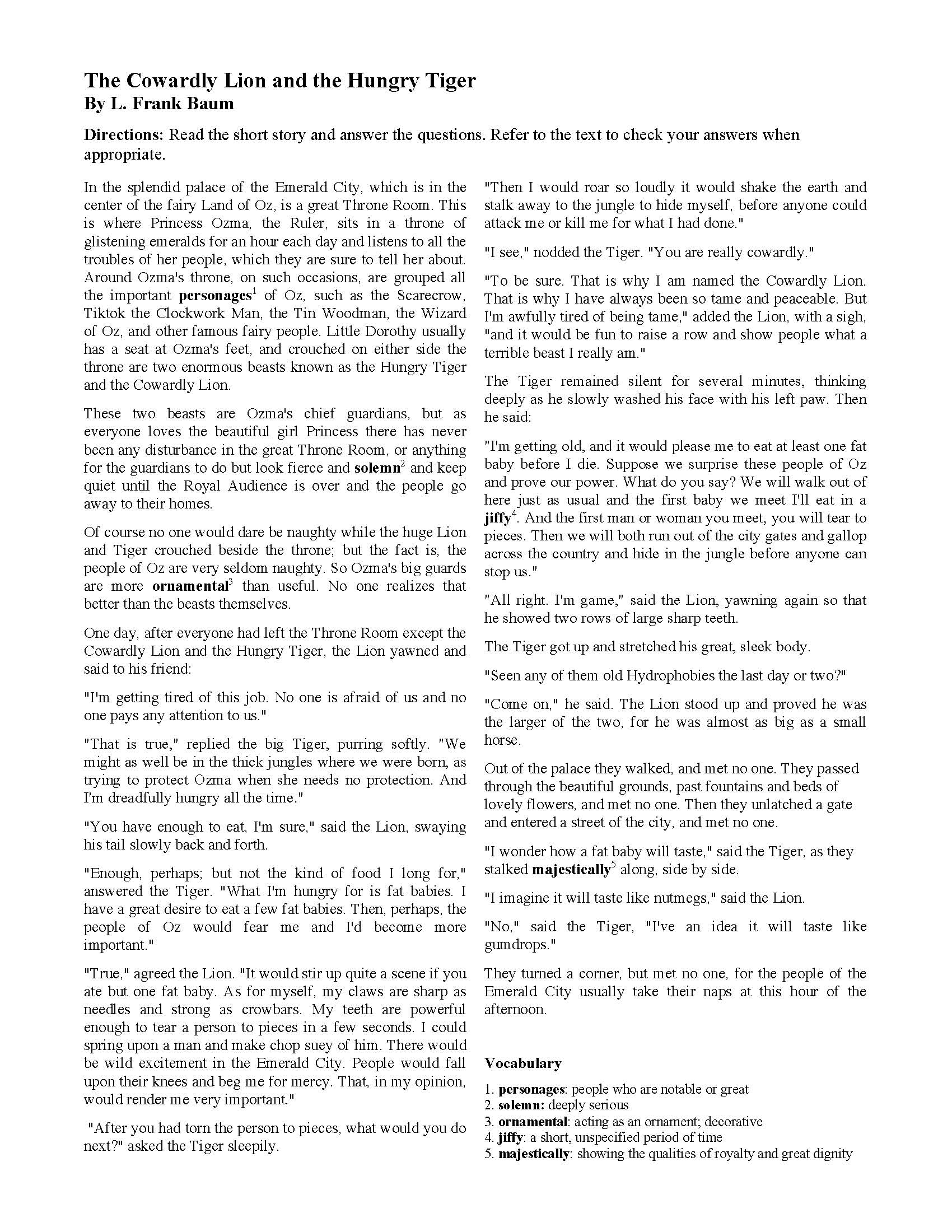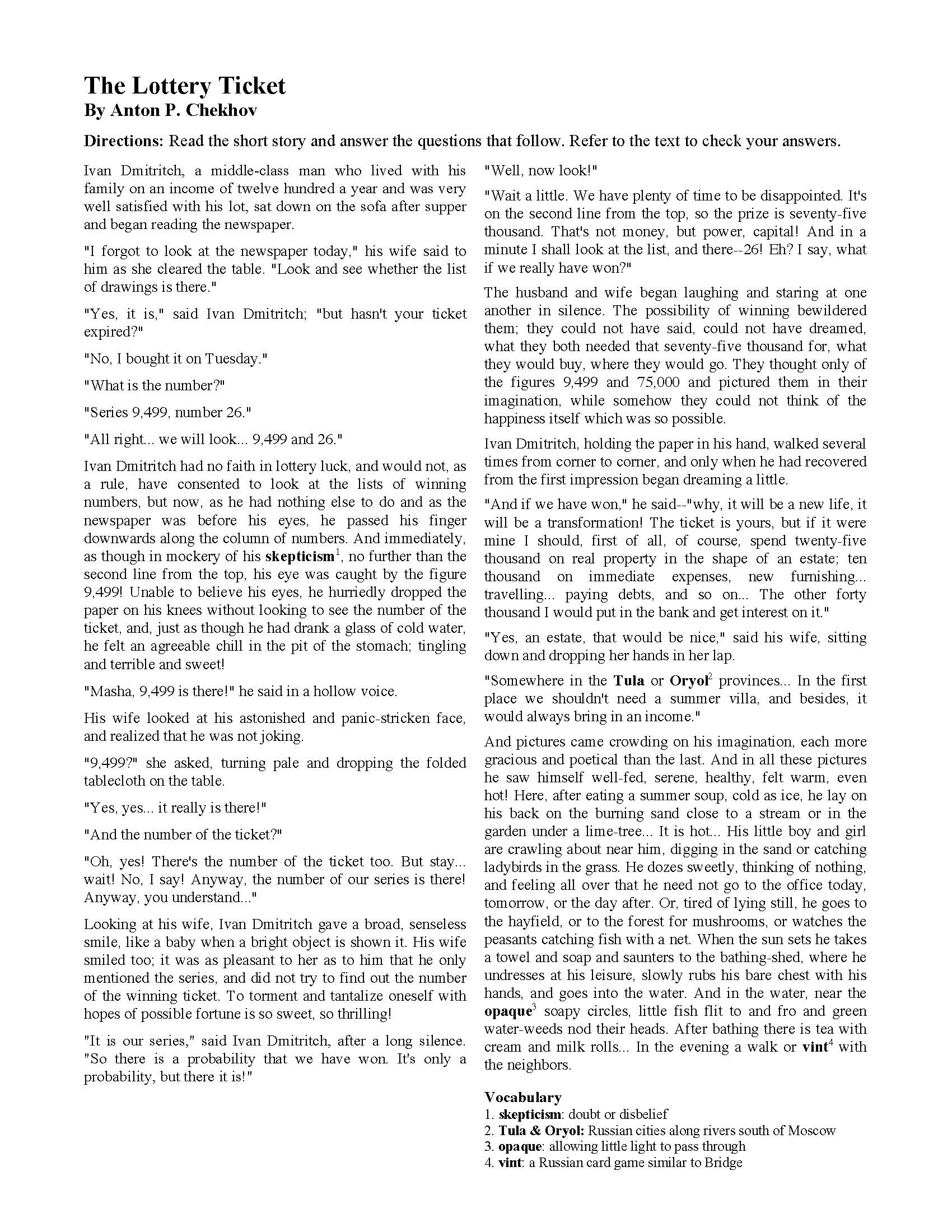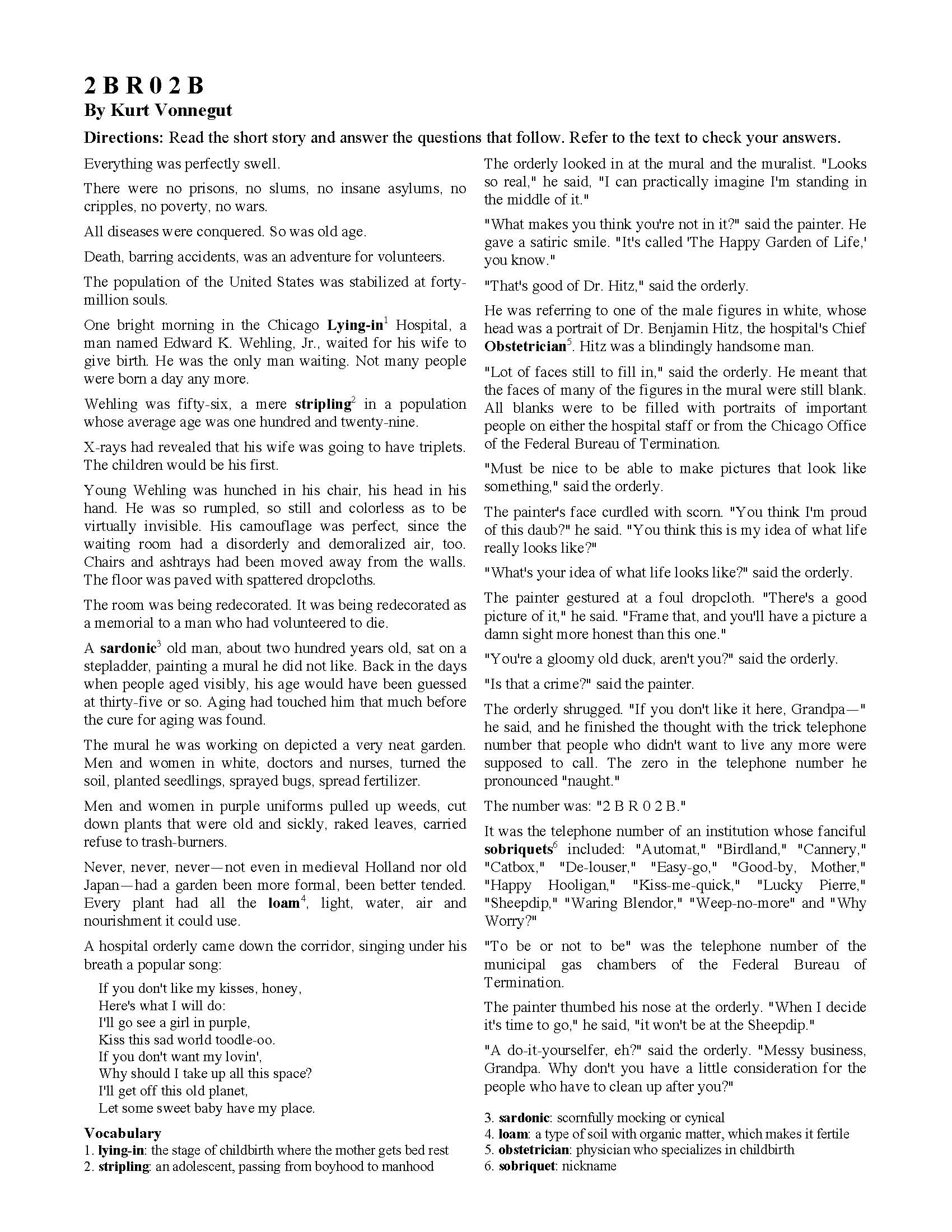
This page features 22 of my favorite short stories with questions. These reading activities are perfect for classroom use. Written by some of the greatest authors in history, these stories are short enough to cover in a single class period, and rich enough to warrant study. I tried to select stories that students would find highly interesting. I chose stories with ironic endings, interesting twists, and clever plot movements. This collection will nurture your students' love of reading and storytelling. I also prepared ten multiple-choice and long response questions for each text. These questions cover a range of reading skills from comprehension and inferring to interpreting themes and identifying figurative language techniques.
These reading activities are available in both the old-school paper format (.RTF and .PDF) and the updated Ereading Worksheet format. With the print-out versions, I optimized to reduce paper use. Most of these fit onto 4 sides. With the new Ereading Worksheets (online versions), I was not limited by paper sides, and was able to ask follow-up short response questions to each multiple-choice. I recommend that you use these if you have the tech at your disposal. They can be completed on any Internet connected device. Students receive instant feedback, and they can print, save, or email score sheets. They can also share their results on Facebook. These activities are easy to integrate with Google Classroom. Definitions of challenging vocabulary words can be found with one click. And perhaps most importantly, these activities are more accessible to students with disabilities. Without further introduction, I present 22 of my favorite short stories with questions, available as worksheets and online activities.
"Two Leaves"This is a short story taken from Bambi, A Life in the Woods. It is about two leaves having a conversation before the winter. They are gripped with sadness and wonder but find some comfort in one another. Suggested reading level for this text: Grade 3-7.






This is the humorous story of a couple guys chasing after fortune during the Klondike Gold Rush. They acquire a mischievous dog named Spot and just cannot get rid of him. This one will have your students in stitches. Suggested reading level for this text: Grade 3-7.






From the man who imagined the Land of Oz comes a short story about peer pressure and testing one's morals. Students will like reading about these memorable characters and they should find the ironic outcome to be humorous. Suggested reading level for this text: Grade 3-7.






This story is one of Andersen's lesser known works. Yet, much like his other works, this story delivers a powerful moral. This story is about a personified tree that fails to appreciate his life until it is too late. Suggested reading level for this text: Grade 3-7.






This short story was written and set during the first World War. It has both humor and sharp social commentary. Readers see that the sacrifices made in the name of war are not equal. Yet the ironic tone of the piece makes it quite enjoyable. Suggested reading level for this text: Grade 4-8.






Written in the style of a folktale, this Kipling classic explains the origins of the domestic cat. This fun and cleverly written tale was borrowed from Kipling's Just So Stories. It is a great tale to study when discussing folkloric traits. Suggested reading level for this text: Grade 4-8.






This is probably O. Henry's best known work. It is the classic Christmas tale of a young couple who sacrifice their most valued treasures for one another. It is a story that sticks with readers. Suggested reading level for this text: Grade 5-9.






This is the story of a young man who overcomes fierce and unforgiving opposition. He uses his wits to become the most successful hunter in his tribe's history. It is an uplifting tale with inspirational themes. Suggested reading level for this text: Grade 5-9.






Written by Oscar Wilde in his signature style of prosetry (poetic prose), this is a cautionary tale about the hazards of giving someone your all. This tragic tale is densely packed with figurative language and narrative quirks and will surely prove the worthy subject of an interesting classroom discussion. Suggested reading level for this text: Grade 5-9.






This is one of Poe's more accessible works. When I teach this text, I tend to play up the insanity of the narrator. It makes for a pretty good hook. This is also a good text to study when discussing the reliability of the narrator. Warning: This text contains a murder and may be unsuitable for some audiences. Suggested reading level for this text: Grade 5-9.






A wise man once said, "Mo'money; mo'problems." This Chekhov classic brings those harsh words to life. The story is about a married couple who have a close encounter with a winning lottery ticket. This story helps to remind readers about what's really important in life. Suggested reading level for this text: Grade 5-9.






This is the classic O. Henry tale of a pair of kidnappers who find themselves at the mercy of their hostage. It's hard to read this one without laughing out loud at least a few times. Suggested reading level for this text: Grade 5-9.






An unreliable narrator is not to be trusted but can be quite humorous. This story by Barrie (better known for creating Peter Pan) features an unreliable narrator of the most hilarious sort. You'll have to read this story for yourself to understand my point. But you'll get some giggles out of this one. Suggested reading level for this text: Grade 6-10






This short science fiction story (pronounced "To be or not to be") gives readers a glimpse into a world where people do not age. Whether this world is utopian or dystopian may lead to a worthwhile discussion about what makes life worth living. WARNING: This text contains murder. Please read it first to make sure it is appropriate for your students. Suggested reading level for this text: Grade 6-10.






This is a thoughtful yet simply written piece set during a battle in the American Civil War. Crane, while capturing the terror and foolishness of war, dispels a heroic myth. WARNING: This text contains graphic descriptions of a violent battle. Suggested reading level for this text: Grade 6-10.






Anyone who's ever gone on a snipe hunt or been sent to pursue the ever elusive jackalope will appreciate this story. Students will find delight in the humorous tone and plot movement of this text, so much so that they may not even get hung up on the bits of dialect. Suggested reading level for this text: Grade 6-10.






What would you do if you found buried treasure but you weren't allowed to take it? This story explores this common conundrum. Students will love the tense moments and ironic twist at the end if they can get past the storyteller's thick dialect. Suggested reading level for this text: Grade 6-10.






A houseguest causes tension and excitement in a married woman's home. As with some of Chopin's other texts, this story deals with issues of infidelity, or at least the implications of such; however, if you are working with a mature group of students, this story is worth studying. Still, BE SURE TO READ THIS STORY FIRST BEFORE ASSIGNING IT. Suggested reading level for this text: Grade 7-11.






This is the tale of a boxer who has come to the twilight of his career. The narrator follows him from his home to the ring, and readers learn about the passage from youth to wisdom. The resolution is unforgettable. Suggested reading level for this text: Grade 7-11.






This short story (taken from Hesse's masterpiece Siddhartha) teaches readers about parenting and the limitations of love. The great spiritual questions in this text may fuel a heated discussion in your classroom. I highly recommend reading the whole book, but this text works pretty well by itself too. Suggested reading level for this text: Grade 7-11.






It's important to not dwell on your failures too much. This story illustrates that point in a dark and controversial way. WARNING: This text contains a suicide. Suggested reading level for this text: Grade 7-11.






It can be hard to win the game when you play by the rules. This short story displays Twain's bitting satire in full bloom. Suggested reading level for this text: Grade 8-12.






I hope that these stories and resources help you accomplish your goals. Please let me know if you find any errors or have any feedback. Leave a comment below or contact me directly at mortonteaches@gmail.com. Thank you for visiting my website.

RL.K.10 - Actively engage in group reading activities with purpose and understanding.
RL.1.10 - With prompting and support, read prose and poetry of appropriate complexity for grade 1.
RL.2.10 - By the end of the year, read and comprehend literature, including stories and poetry, in the grades 2–3 text complexity band proficiently, with scaffolding as needed at the high end of the range.
RL.3.10 - By the end of the year, read and comprehend literature, including stories, dramas, and poetry, at the high end of the grades 2–3 text complexity band independently and proficiently.
RL.4.10 - By the end of the year, read and comprehend literature, including stories, dramas, and poetry, in the grades 4–5 text complexity band proficiently, with scaffolding as needed at the high end of the range.
RL.5.10 - By the end of the year, read and comprehend literature, including stories, dramas, and poetry, at the high end of the grades 4–5 text complexity band independently and proficiently.
RL.6.10 - By the end of the year, read and comprehend literature, including stories, dramas, and poems, in the grades 6–8 text complexity band proficiently, with scaffolding as needed at the high end of the range.
RL.7.10 - By the end of the year, read and comprehend literature, including stories, dramas, and poems, in the grades 6–8 text complexity band proficiently, with scaffolding as needed at the high end of the range.
RL.8.10 - By the end of the year, read and comprehend literature, including stories, dramas, and poems, at the high end of grades 6–8 text complexity band independently and proficiently.
RL.9.10 - By the end of grade 9, read and comprehend literature, including stories, dramas, and poems, in the grades 9–10 text complexity band proficiently, with scaffolding as needed at the high end of the range.
RL.10.10 - By the end of grade 10, read and comprehend literature, including stories, dramas, and poems, at the high end of the grades 9–10 text complexity band independently and proficiently.
RL.11.10 - By the end of grade 11, read and comprehend literature, including stories, dramas, and poems, in the grades 11–CCR text complexity band proficiently, with scaffolding as needed at the high end of the range.
RL.12.10 - By the end of grade 12, read and comprehend literature, including stories, dramas, and poems, at the high end of the grades 11–CCR text complexity band independently and proficiently.